Analysis of Healthcare Policy and Greenhouse Gas Emissions in the USA
VerifiedAdded on 2022/08/21
|6
|1599
|8
Essay
AI Summary
This essay examines the significant impact of the US healthcare system on greenhouse gas emissions and its implications for public health. The paper highlights that the healthcare sector is a major contributor to pollution, affecting air, water, and soil quality. It details how the sector's energy-intensive operations, including hospitals and pharmaceutical departments, contribute to carbon footprints. The essay reviews current government policies, such as the Clean Air Act and various research programs, aimed at reducing emissions and promoting clean energy technologies. It also discusses initiatives by healthcare providers like Kaiser Permanente, the University of California Health System, and the Cleveland Clinic to achieve carbon neutrality. The paper emphasizes the need for effective federal policies and sustainable development practices to mitigate the negative environmental and health effects associated with the healthcare sector's emissions. It also mentions the role of natural disasters in damaging healthcare sectors and increasing emissions. The essay concludes by summarizing that the US healthcare system is a major source of greenhouse gas emissions and emphasizes the necessity of addressing the issue of carbon footprints for global climate change.
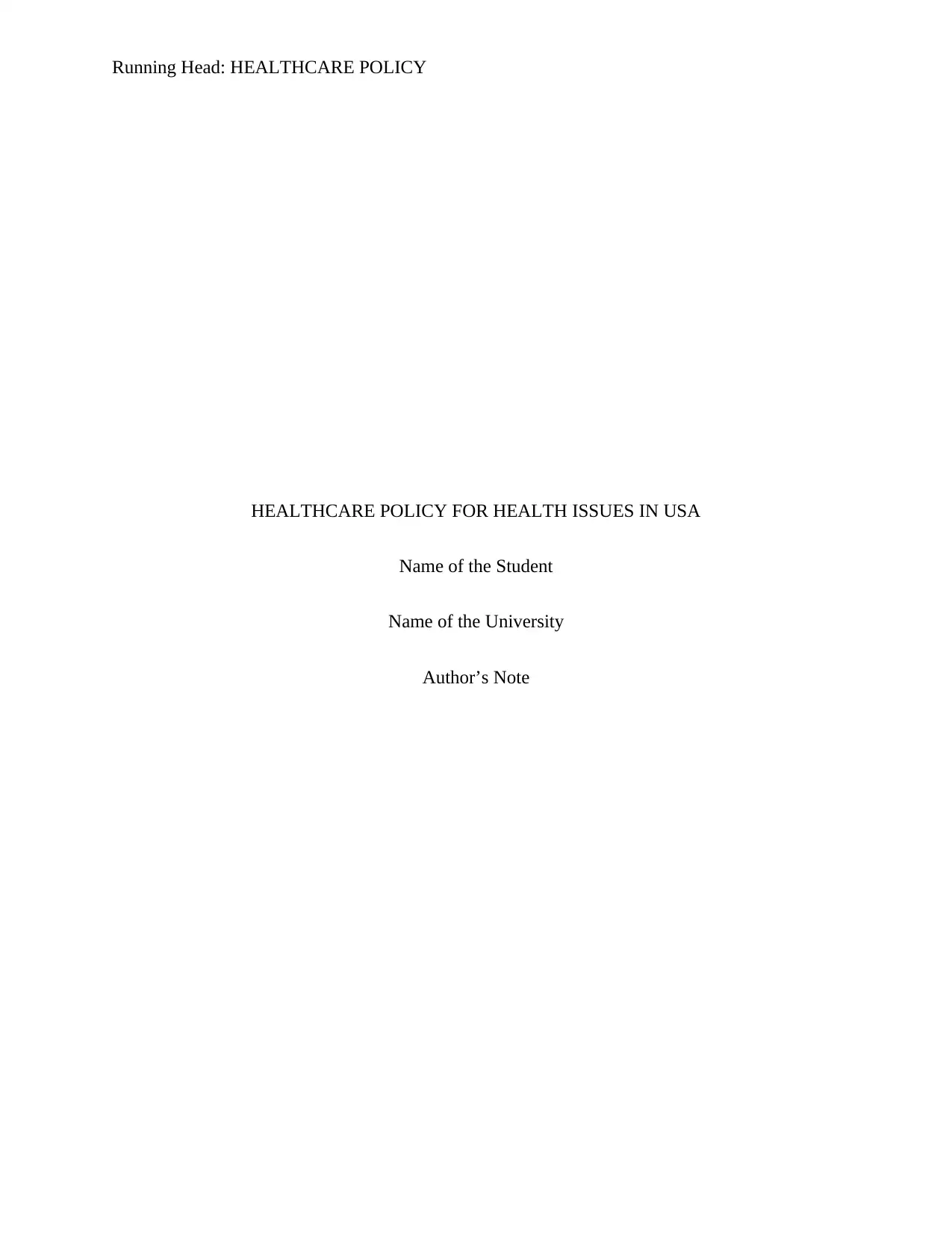
Running Head: HEALTHCARE POLICY
HEALTHCARE POLICY FOR HEALTH ISSUES IN USA
Name of the Student
Name of the University
Author’s Note
HEALTHCARE POLICY FOR HEALTH ISSUES IN USA
Name of the Student
Name of the University
Author’s Note
Paraphrase This Document
Need a fresh take? Get an instant paraphrase of this document with our AI Paraphraser
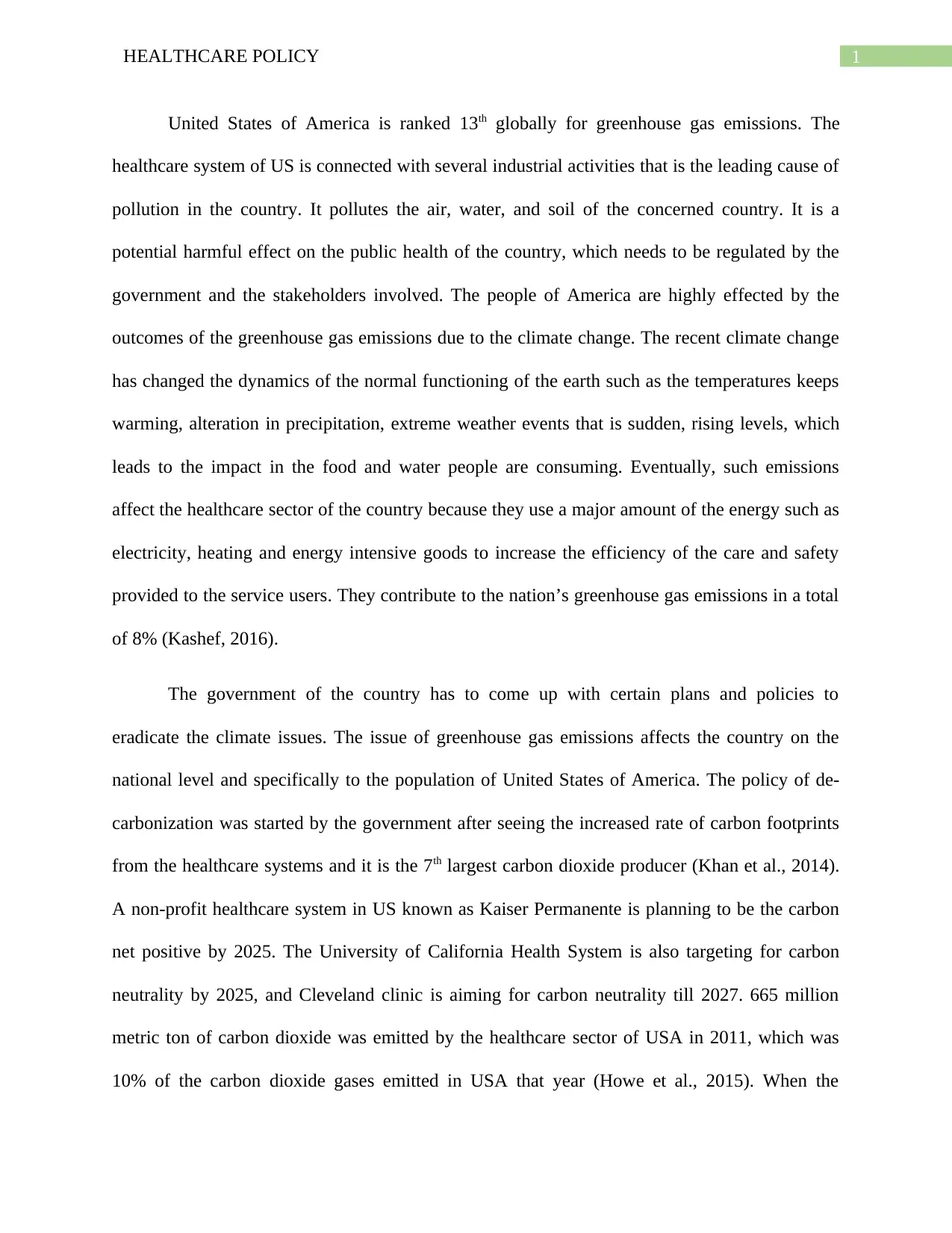
1HEALTHCARE POLICY
United States of America is ranked 13th globally for greenhouse gas emissions. The
healthcare system of US is connected with several industrial activities that is the leading cause of
pollution in the country. It pollutes the air, water, and soil of the concerned country. It is a
potential harmful effect on the public health of the country, which needs to be regulated by the
government and the stakeholders involved. The people of America are highly effected by the
outcomes of the greenhouse gas emissions due to the climate change. The recent climate change
has changed the dynamics of the normal functioning of the earth such as the temperatures keeps
warming, alteration in precipitation, extreme weather events that is sudden, rising levels, which
leads to the impact in the food and water people are consuming. Eventually, such emissions
affect the healthcare sector of the country because they use a major amount of the energy such as
electricity, heating and energy intensive goods to increase the efficiency of the care and safety
provided to the service users. They contribute to the nation’s greenhouse gas emissions in a total
of 8% (Kashef, 2016).
The government of the country has to come up with certain plans and policies to
eradicate the climate issues. The issue of greenhouse gas emissions affects the country on the
national level and specifically to the population of United States of America. The policy of de-
carbonization was started by the government after seeing the increased rate of carbon footprints
from the healthcare systems and it is the 7th largest carbon dioxide producer (Khan et al., 2014).
A non-profit healthcare system in US known as Kaiser Permanente is planning to be the carbon
net positive by 2025. The University of California Health System is also targeting for carbon
neutrality by 2025, and Cleveland clinic is aiming for carbon neutrality till 2027. 665 million
metric ton of carbon dioxide was emitted by the healthcare sector of USA in 2011, which was
10% of the carbon dioxide gases emitted in USA that year (Howe et al., 2015). When the
United States of America is ranked 13th globally for greenhouse gas emissions. The
healthcare system of US is connected with several industrial activities that is the leading cause of
pollution in the country. It pollutes the air, water, and soil of the concerned country. It is a
potential harmful effect on the public health of the country, which needs to be regulated by the
government and the stakeholders involved. The people of America are highly effected by the
outcomes of the greenhouse gas emissions due to the climate change. The recent climate change
has changed the dynamics of the normal functioning of the earth such as the temperatures keeps
warming, alteration in precipitation, extreme weather events that is sudden, rising levels, which
leads to the impact in the food and water people are consuming. Eventually, such emissions
affect the healthcare sector of the country because they use a major amount of the energy such as
electricity, heating and energy intensive goods to increase the efficiency of the care and safety
provided to the service users. They contribute to the nation’s greenhouse gas emissions in a total
of 8% (Kashef, 2016).
The government of the country has to come up with certain plans and policies to
eradicate the climate issues. The issue of greenhouse gas emissions affects the country on the
national level and specifically to the population of United States of America. The policy of de-
carbonization was started by the government after seeing the increased rate of carbon footprints
from the healthcare systems and it is the 7th largest carbon dioxide producer (Khan et al., 2014).
A non-profit healthcare system in US known as Kaiser Permanente is planning to be the carbon
net positive by 2025. The University of California Health System is also targeting for carbon
neutrality by 2025, and Cleveland clinic is aiming for carbon neutrality till 2027. 665 million
metric ton of carbon dioxide was emitted by the healthcare sector of USA in 2011, which was
10% of the carbon dioxide gases emitted in USA that year (Howe et al., 2015). When the
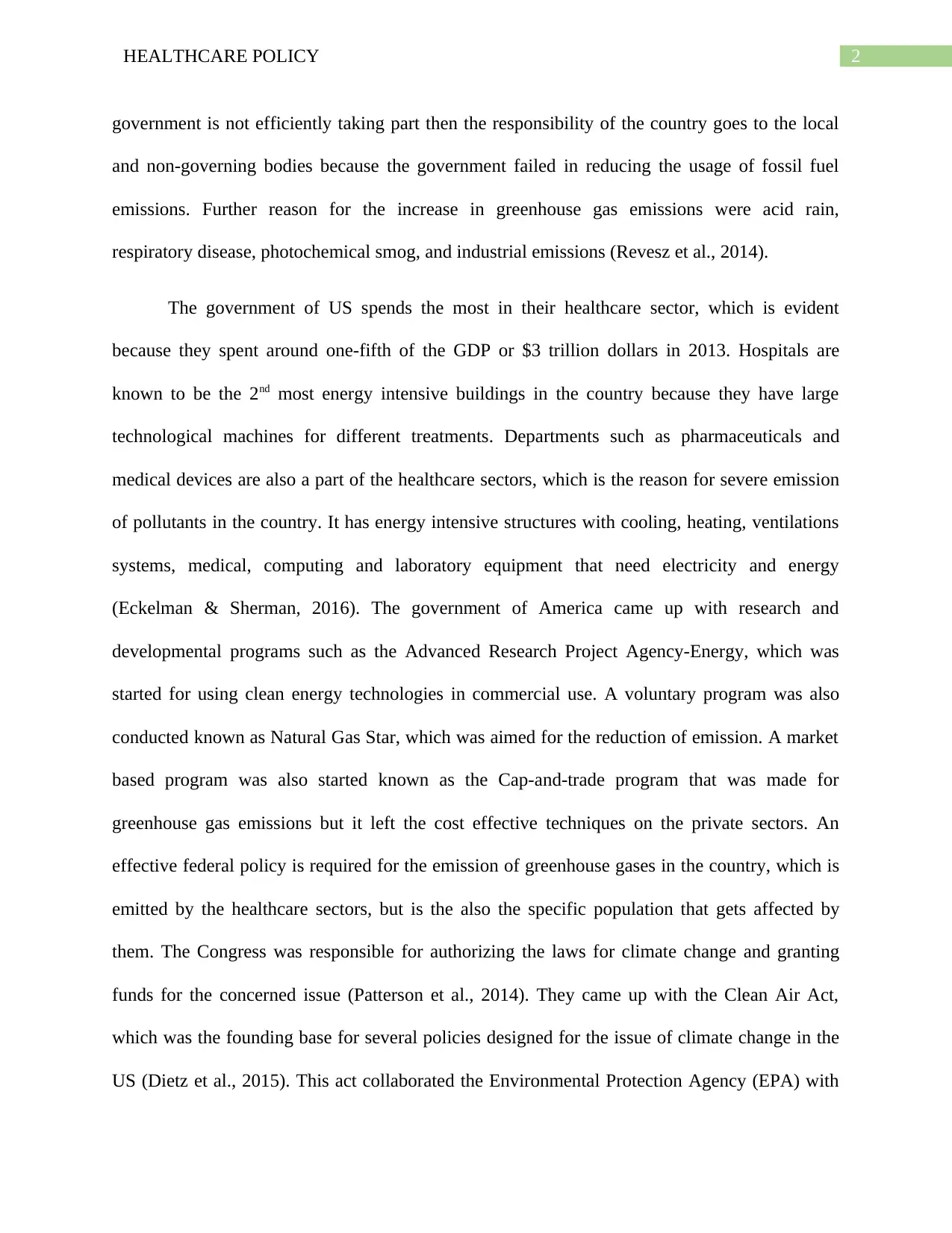
2HEALTHCARE POLICY
government is not efficiently taking part then the responsibility of the country goes to the local
and non-governing bodies because the government failed in reducing the usage of fossil fuel
emissions. Further reason for the increase in greenhouse gas emissions were acid rain,
respiratory disease, photochemical smog, and industrial emissions (Revesz et al., 2014).
The government of US spends the most in their healthcare sector, which is evident
because they spent around one-fifth of the GDP or $3 trillion dollars in 2013. Hospitals are
known to be the 2nd most energy intensive buildings in the country because they have large
technological machines for different treatments. Departments such as pharmaceuticals and
medical devices are also a part of the healthcare sectors, which is the reason for severe emission
of pollutants in the country. It has energy intensive structures with cooling, heating, ventilations
systems, medical, computing and laboratory equipment that need electricity and energy
(Eckelman & Sherman, 2016). The government of America came up with research and
developmental programs such as the Advanced Research Project Agency-Energy, which was
started for using clean energy technologies in commercial use. A voluntary program was also
conducted known as Natural Gas Star, which was aimed for the reduction of emission. A market
based program was also started known as the Cap-and-trade program that was made for
greenhouse gas emissions but it left the cost effective techniques on the private sectors. An
effective federal policy is required for the emission of greenhouse gases in the country, which is
emitted by the healthcare sectors, but is the also the specific population that gets affected by
them. The Congress was responsible for authorizing the laws for climate change and granting
funds for the concerned issue (Patterson et al., 2014). They came up with the Clean Air Act,
which was the founding base for several policies designed for the issue of climate change in the
US (Dietz et al., 2015). This act collaborated the Environmental Protection Agency (EPA) with
government is not efficiently taking part then the responsibility of the country goes to the local
and non-governing bodies because the government failed in reducing the usage of fossil fuel
emissions. Further reason for the increase in greenhouse gas emissions were acid rain,
respiratory disease, photochemical smog, and industrial emissions (Revesz et al., 2014).
The government of US spends the most in their healthcare sector, which is evident
because they spent around one-fifth of the GDP or $3 trillion dollars in 2013. Hospitals are
known to be the 2nd most energy intensive buildings in the country because they have large
technological machines for different treatments. Departments such as pharmaceuticals and
medical devices are also a part of the healthcare sectors, which is the reason for severe emission
of pollutants in the country. It has energy intensive structures with cooling, heating, ventilations
systems, medical, computing and laboratory equipment that need electricity and energy
(Eckelman & Sherman, 2016). The government of America came up with research and
developmental programs such as the Advanced Research Project Agency-Energy, which was
started for using clean energy technologies in commercial use. A voluntary program was also
conducted known as Natural Gas Star, which was aimed for the reduction of emission. A market
based program was also started known as the Cap-and-trade program that was made for
greenhouse gas emissions but it left the cost effective techniques on the private sectors. An
effective federal policy is required for the emission of greenhouse gases in the country, which is
emitted by the healthcare sectors, but is the also the specific population that gets affected by
them. The Congress was responsible for authorizing the laws for climate change and granting
funds for the concerned issue (Patterson et al., 2014). They came up with the Clean Air Act,
which was the founding base for several policies designed for the issue of climate change in the
US (Dietz et al., 2015). This act collaborated the Environmental Protection Agency (EPA) with
⊘ This is a preview!⊘
Do you want full access?
Subscribe today to unlock all pages.

Trusted by 1+ million students worldwide
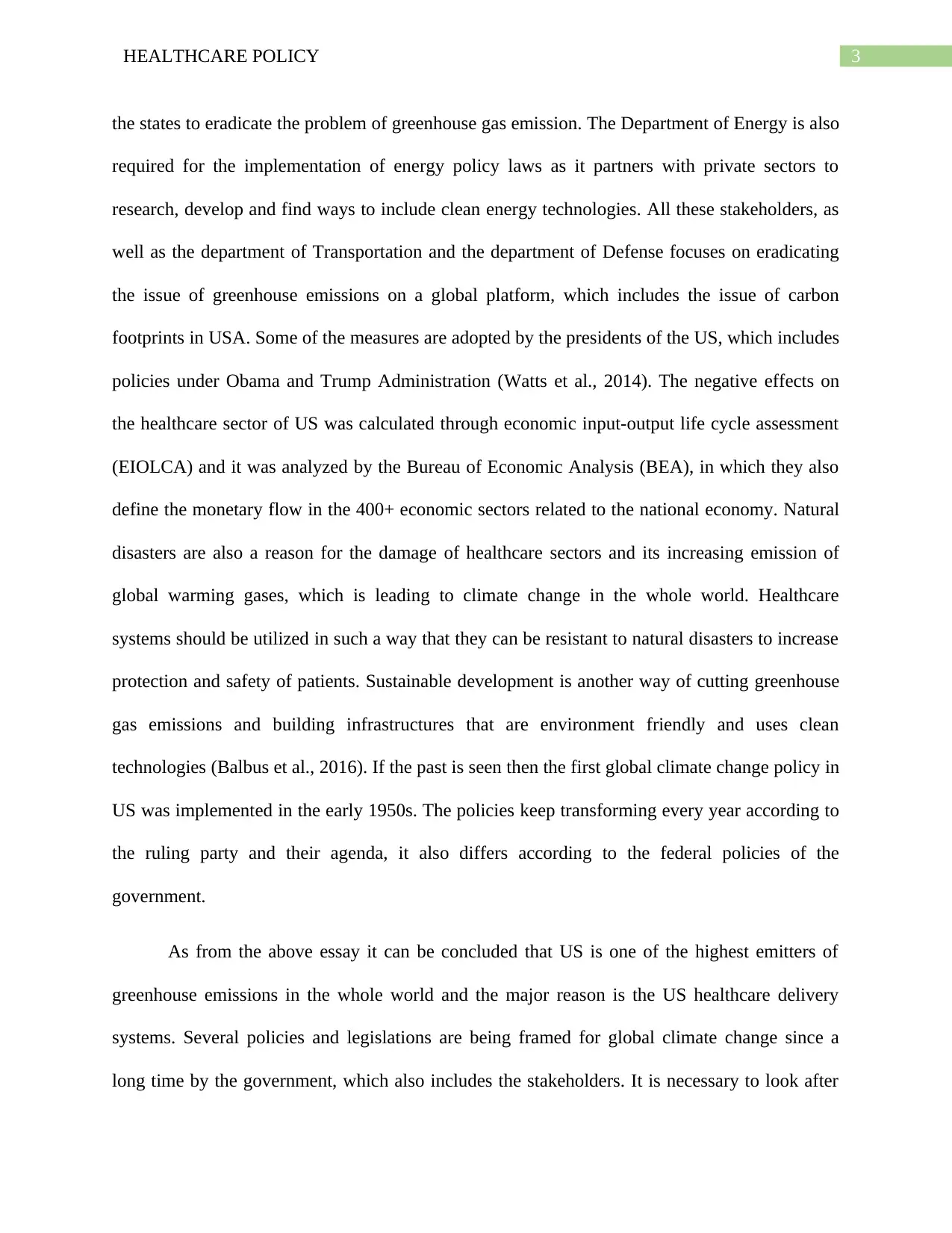
3HEALTHCARE POLICY
the states to eradicate the problem of greenhouse gas emission. The Department of Energy is also
required for the implementation of energy policy laws as it partners with private sectors to
research, develop and find ways to include clean energy technologies. All these stakeholders, as
well as the department of Transportation and the department of Defense focuses on eradicating
the issue of greenhouse emissions on a global platform, which includes the issue of carbon
footprints in USA. Some of the measures are adopted by the presidents of the US, which includes
policies under Obama and Trump Administration (Watts et al., 2014). The negative effects on
the healthcare sector of US was calculated through economic input-output life cycle assessment
(EIOLCA) and it was analyzed by the Bureau of Economic Analysis (BEA), in which they also
define the monetary flow in the 400+ economic sectors related to the national economy. Natural
disasters are also a reason for the damage of healthcare sectors and its increasing emission of
global warming gases, which is leading to climate change in the whole world. Healthcare
systems should be utilized in such a way that they can be resistant to natural disasters to increase
protection and safety of patients. Sustainable development is another way of cutting greenhouse
gas emissions and building infrastructures that are environment friendly and uses clean
technologies (Balbus et al., 2016). If the past is seen then the first global climate change policy in
US was implemented in the early 1950s. The policies keep transforming every year according to
the ruling party and their agenda, it also differs according to the federal policies of the
government.
As from the above essay it can be concluded that US is one of the highest emitters of
greenhouse emissions in the whole world and the major reason is the US healthcare delivery
systems. Several policies and legislations are being framed for global climate change since a
long time by the government, which also includes the stakeholders. It is necessary to look after
the states to eradicate the problem of greenhouse gas emission. The Department of Energy is also
required for the implementation of energy policy laws as it partners with private sectors to
research, develop and find ways to include clean energy technologies. All these stakeholders, as
well as the department of Transportation and the department of Defense focuses on eradicating
the issue of greenhouse emissions on a global platform, which includes the issue of carbon
footprints in USA. Some of the measures are adopted by the presidents of the US, which includes
policies under Obama and Trump Administration (Watts et al., 2014). The negative effects on
the healthcare sector of US was calculated through economic input-output life cycle assessment
(EIOLCA) and it was analyzed by the Bureau of Economic Analysis (BEA), in which they also
define the monetary flow in the 400+ economic sectors related to the national economy. Natural
disasters are also a reason for the damage of healthcare sectors and its increasing emission of
global warming gases, which is leading to climate change in the whole world. Healthcare
systems should be utilized in such a way that they can be resistant to natural disasters to increase
protection and safety of patients. Sustainable development is another way of cutting greenhouse
gas emissions and building infrastructures that are environment friendly and uses clean
technologies (Balbus et al., 2016). If the past is seen then the first global climate change policy in
US was implemented in the early 1950s. The policies keep transforming every year according to
the ruling party and their agenda, it also differs according to the federal policies of the
government.
As from the above essay it can be concluded that US is one of the highest emitters of
greenhouse emissions in the whole world and the major reason is the US healthcare delivery
systems. Several policies and legislations are being framed for global climate change since a
long time by the government, which also includes the stakeholders. It is necessary to look after
Paraphrase This Document
Need a fresh take? Get an instant paraphrase of this document with our AI Paraphraser
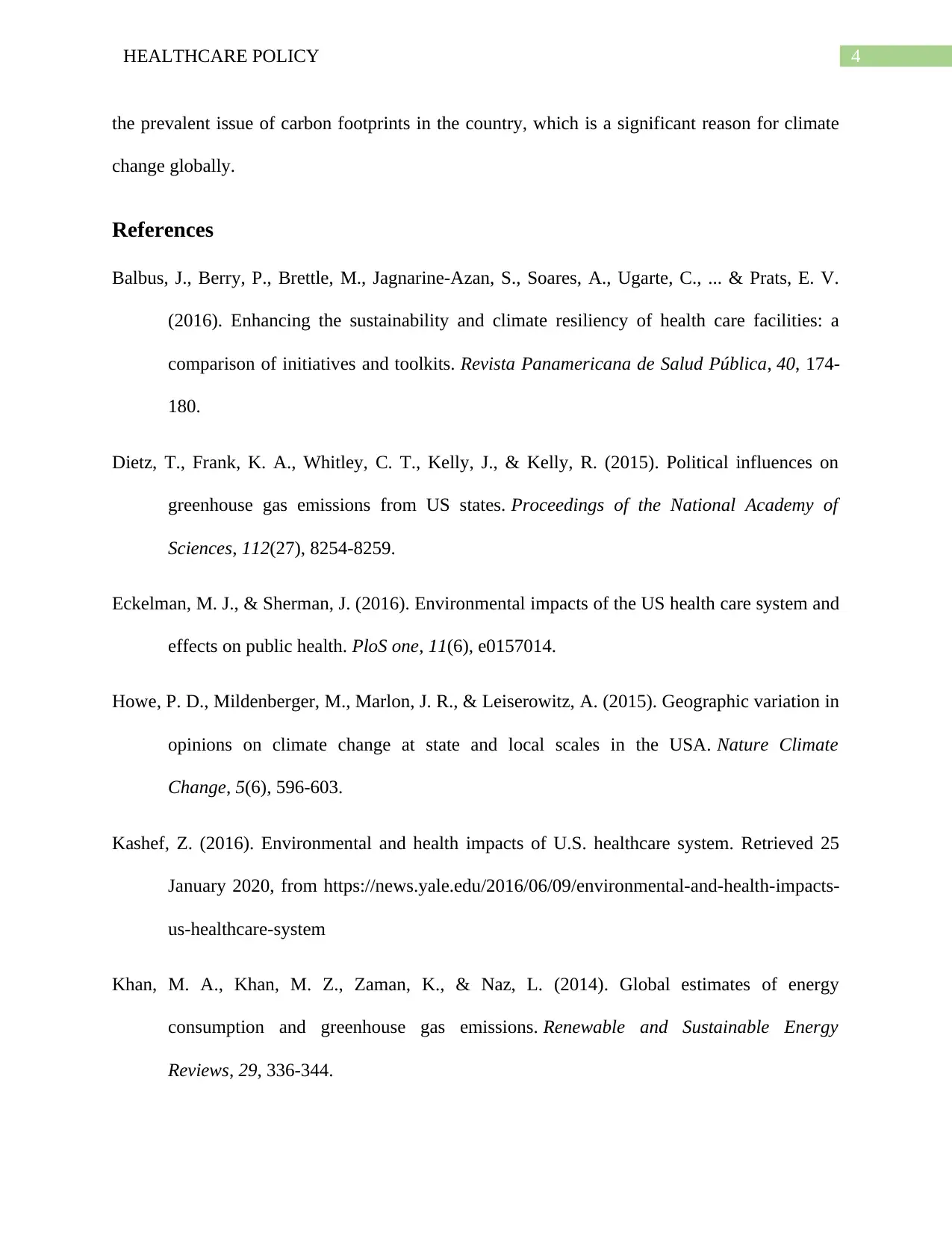
4HEALTHCARE POLICY
the prevalent issue of carbon footprints in the country, which is a significant reason for climate
change globally.
References
Balbus, J., Berry, P., Brettle, M., Jagnarine-Azan, S., Soares, A., Ugarte, C., ... & Prats, E. V.
(2016). Enhancing the sustainability and climate resiliency of health care facilities: a
comparison of initiatives and toolkits. Revista Panamericana de Salud Pública, 40, 174-
180.
Dietz, T., Frank, K. A., Whitley, C. T., Kelly, J., & Kelly, R. (2015). Political influences on
greenhouse gas emissions from US states. Proceedings of the National Academy of
Sciences, 112(27), 8254-8259.
Eckelman, M. J., & Sherman, J. (2016). Environmental impacts of the US health care system and
effects on public health. PloS one, 11(6), e0157014.
Howe, P. D., Mildenberger, M., Marlon, J. R., & Leiserowitz, A. (2015). Geographic variation in
opinions on climate change at state and local scales in the USA. Nature Climate
Change, 5(6), 596-603.
Kashef, Z. (2016). Environmental and health impacts of U.S. healthcare system. Retrieved 25
January 2020, from https://news.yale.edu/2016/06/09/environmental-and-health-impacts-
us-healthcare-system
Khan, M. A., Khan, M. Z., Zaman, K., & Naz, L. (2014). Global estimates of energy
consumption and greenhouse gas emissions. Renewable and Sustainable Energy
Reviews, 29, 336-344.
the prevalent issue of carbon footprints in the country, which is a significant reason for climate
change globally.
References
Balbus, J., Berry, P., Brettle, M., Jagnarine-Azan, S., Soares, A., Ugarte, C., ... & Prats, E. V.
(2016). Enhancing the sustainability and climate resiliency of health care facilities: a
comparison of initiatives and toolkits. Revista Panamericana de Salud Pública, 40, 174-
180.
Dietz, T., Frank, K. A., Whitley, C. T., Kelly, J., & Kelly, R. (2015). Political influences on
greenhouse gas emissions from US states. Proceedings of the National Academy of
Sciences, 112(27), 8254-8259.
Eckelman, M. J., & Sherman, J. (2016). Environmental impacts of the US health care system and
effects on public health. PloS one, 11(6), e0157014.
Howe, P. D., Mildenberger, M., Marlon, J. R., & Leiserowitz, A. (2015). Geographic variation in
opinions on climate change at state and local scales in the USA. Nature Climate
Change, 5(6), 596-603.
Kashef, Z. (2016). Environmental and health impacts of U.S. healthcare system. Retrieved 25
January 2020, from https://news.yale.edu/2016/06/09/environmental-and-health-impacts-
us-healthcare-system
Khan, M. A., Khan, M. Z., Zaman, K., & Naz, L. (2014). Global estimates of energy
consumption and greenhouse gas emissions. Renewable and Sustainable Energy
Reviews, 29, 336-344.
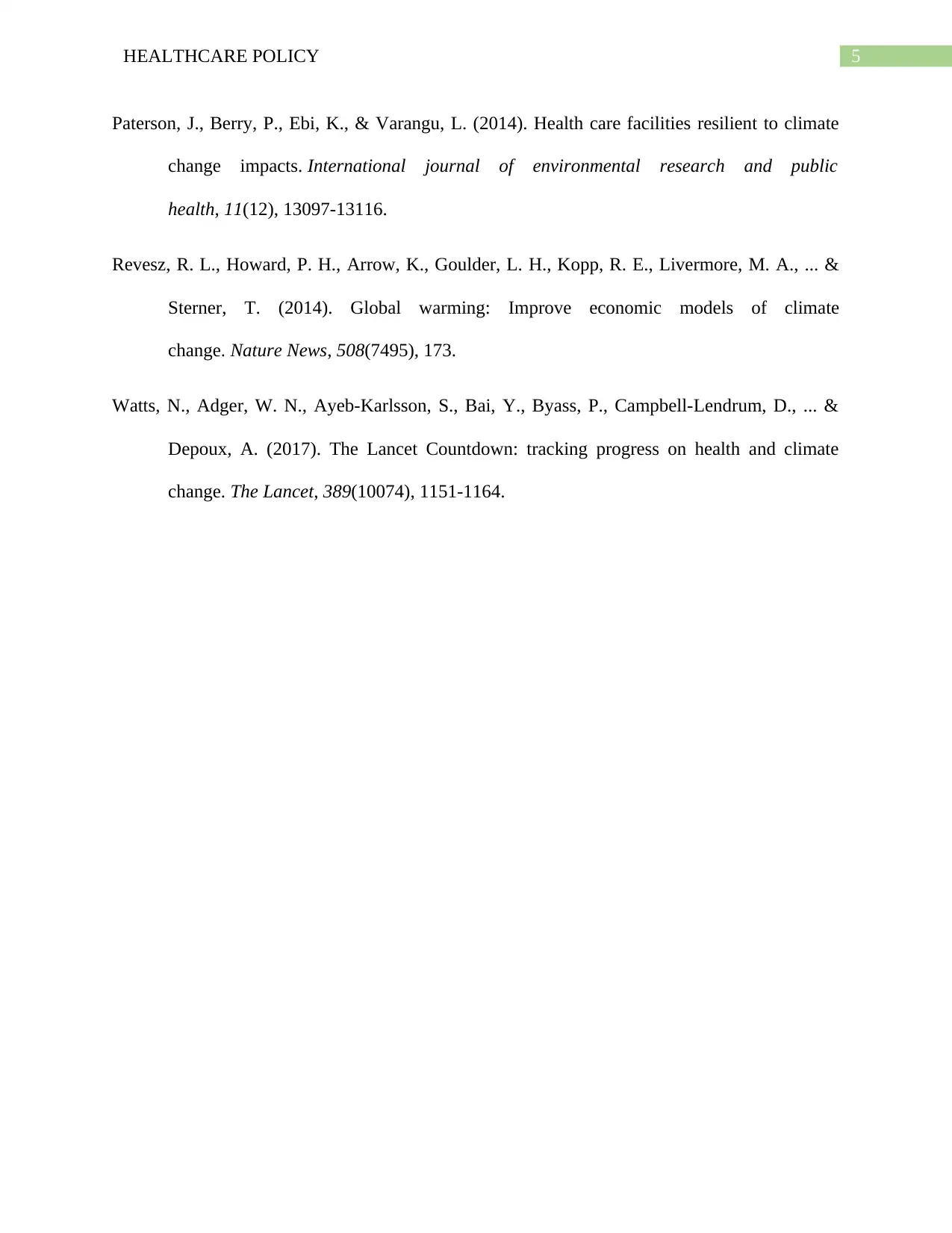
5HEALTHCARE POLICY
Paterson, J., Berry, P., Ebi, K., & Varangu, L. (2014). Health care facilities resilient to climate
change impacts. International journal of environmental research and public
health, 11(12), 13097-13116.
Revesz, R. L., Howard, P. H., Arrow, K., Goulder, L. H., Kopp, R. E., Livermore, M. A., ... &
Sterner, T. (2014). Global warming: Improve economic models of climate
change. Nature News, 508(7495), 173.
Watts, N., Adger, W. N., Ayeb-Karlsson, S., Bai, Y., Byass, P., Campbell-Lendrum, D., ... &
Depoux, A. (2017). The Lancet Countdown: tracking progress on health and climate
change. The Lancet, 389(10074), 1151-1164.
Paterson, J., Berry, P., Ebi, K., & Varangu, L. (2014). Health care facilities resilient to climate
change impacts. International journal of environmental research and public
health, 11(12), 13097-13116.
Revesz, R. L., Howard, P. H., Arrow, K., Goulder, L. H., Kopp, R. E., Livermore, M. A., ... &
Sterner, T. (2014). Global warming: Improve economic models of climate
change. Nature News, 508(7495), 173.
Watts, N., Adger, W. N., Ayeb-Karlsson, S., Bai, Y., Byass, P., Campbell-Lendrum, D., ... &
Depoux, A. (2017). The Lancet Countdown: tracking progress on health and climate
change. The Lancet, 389(10074), 1151-1164.
⊘ This is a preview!⊘
Do you want full access?
Subscribe today to unlock all pages.

Trusted by 1+ million students worldwide
1 out of 6
Related Documents
Your All-in-One AI-Powered Toolkit for Academic Success.
+13062052269
info@desklib.com
Available 24*7 on WhatsApp / Email
![[object Object]](/_next/static/media/star-bottom.7253800d.svg)
Unlock your academic potential
Copyright © 2020–2025 A2Z Services. All Rights Reserved. Developed and managed by ZUCOL.





